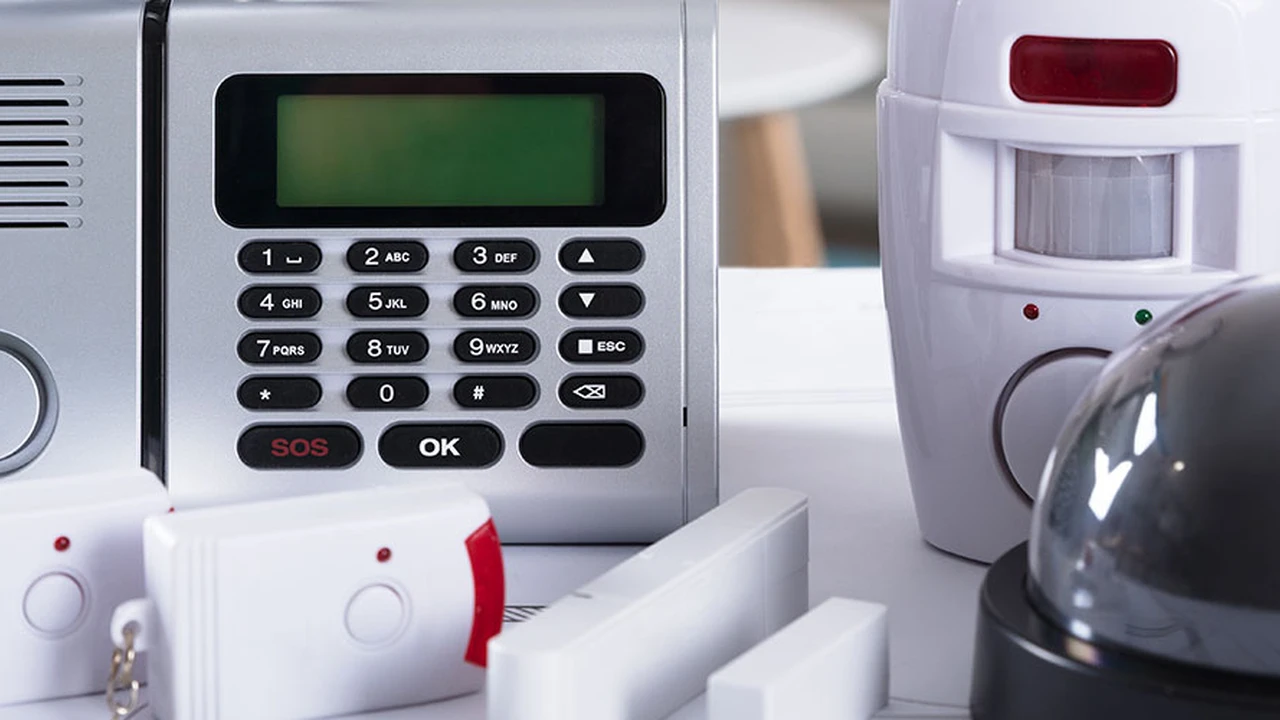3 Key Benefits of Integrated Security Systems
Explore the three most important benefits of integrated security systems for enhanced efficiency and protection.

Explore the three most important benefits of integrated security systems for enhanced efficiency and protection.
3 Key Benefits of Integrated Security Systems
Hey there! Thinking about beefing up your security? You've probably heard a lot about different security gadgets and systems. But what if I told you there's a way to make them all work together, smarter and more efficiently? That's where integrated security systems come in. Instead of having a bunch of standalone systems that don't talk to each other, integration brings everything under one roof. This isn't just about convenience; it's about creating a truly robust and intelligent security posture. Let's dive into the three biggest benefits you get when you choose an integrated approach.
Benefit 1: Enhanced Efficiency and Streamlined Operations with Integrated Security
One of the first things you'll notice with an integrated security system is how much more efficient everything becomes. Imagine this: instead of monitoring separate screens for your CCTV, access control, and alarm systems, you have one central dashboard. This isn't just a nice-to-have; it's a game-changer for security personnel. They can see everything at a glance, respond faster, and manage incidents more effectively.
Centralized Monitoring and Management for Security Systems
With an integrated system, all your security components – think cameras, door sensors, motion detectors, and even fire alarms – feed into a single platform. This means your security team isn't juggling multiple applications or trying to correlate events across disparate systems. If an alarm goes off, the system can automatically pull up live camera feeds from that area, unlock specific doors for emergency personnel, and even notify relevant staff via text or email. This level of automation and centralized control drastically reduces response times and human error.
Reduced Response Times and Improved Incident Handling with Integrated Security
Let's say a motion sensor triggers an alert in a restricted area. In a non-integrated setup, a security guard might get an alert, then have to manually switch to the camera system, find the right camera, and then decide on a course of action. With integration, that motion alert immediately brings up the relevant camera feed on the central monitor. The system can even be programmed to automatically lock down the area, trigger an audible warning, or dispatch a patrol. This proactive and automated response capability is invaluable, especially in critical situations where every second counts.
Cost Savings Through Operational Synergy in Security Integration
While the initial investment in an integrated system might seem higher, the long-term cost savings are significant. You'll often find reduced labor costs because fewer personnel are needed to monitor and manage the system. Maintenance can also be streamlined, as you're dealing with a single vendor or a unified system architecture rather than multiple disparate ones. Plus, the improved efficiency and reduced risk of incidents can lead to lower insurance premiums and fewer losses from theft or damage. It's about working smarter, not just harder.
Benefit 2: Superior Protection and Comprehensive Coverage with Integrated Security Solutions
Beyond efficiency, integrated security systems offer a level of protection that standalone systems simply can't match. When all your security elements are working in concert, they create a much more formidable barrier against threats. It's like having a team of highly trained guards who can communicate instantly and coordinate their actions perfectly.
Holistic Threat Detection and Prevention with Integrated Security
Imagine a scenario where an intruder tries to force open a door. The access control system immediately detects the forced entry. Because it's integrated, the CCTV system automatically focuses cameras on that door, the alarm system triggers, and the lighting system in that area might even flash to disorient the intruder. This multi-layered response is far more effective than a single alarm going off in isolation. Integrated systems can also use advanced analytics to identify suspicious patterns that individual systems might miss, like someone loitering near a sensitive area for an unusual amount of time.
Seamless Integration of Various Security Components for Enhanced Protection
This is where the magic happens. Integrated systems can seamlessly combine:
- Access Control: Managing who goes where and when, with features like biometric scanners, key cards, and mobile credentials.
- Video Surveillance (CCTV): High-definition cameras with analytics for object detection, facial recognition, and license plate recognition.
- Intrusion Detection: Motion sensors, door/window contacts, glass break detectors, and perimeter security.
- Fire and Life Safety: Smoke detectors, heat detectors, carbon monoxide sensors, and sprinkler system integration.
- Intercom and Communication Systems: For two-way communication and visitor management.
- Building Management Systems (BMS): Integrating with HVAC, lighting, and power systems for energy efficiency and security.
When these components are integrated, they don't just coexist; they actively share information and trigger actions based on predefined rules. This creates a truly comprehensive security blanket.
Scalability and Future-Proofing Your Security Investment with Integrated Systems
Another huge advantage is scalability. As your needs grow or technology evolves, an integrated system can be expanded or updated much more easily than a collection of disparate systems. You can add new cameras, sensors, or access points without having to overhaul your entire security infrastructure. This future-proofs your investment, ensuring that your security system remains effective and relevant for years to come. It's a modular approach that allows for flexibility and adaptability.
Benefit 3: Actionable Intelligence and Data-Driven Security Decisions
In today's world, data is king, and security is no exception. Integrated security systems generate a wealth of data that, when properly analyzed, can provide invaluable insights. This isn't just about reacting to incidents; it's about proactively identifying vulnerabilities and making informed decisions to improve your overall security posture.
Advanced Analytics and Reporting for Security Insights
Because all your security data is collected in one place, integrated systems can run sophisticated analytics. You can generate reports on access patterns, alarm frequency, camera activity, and much more. This data can help you identify peak traffic times, areas with frequent unauthorized access attempts, or even equipment that might be malfunctioning. For example, if a particular door consistently triggers false alarms, the data will highlight this, allowing you to investigate and fix the issue.
Proactive Risk Management and Vulnerability Identification with Integrated Security
With the insights gained from advanced analytics, you can move from a reactive to a proactive security strategy. Instead of just responding to breaches, you can identify potential vulnerabilities before they are exploited. For instance, if access logs show that a certain employee is trying to access restricted areas outside their authorized hours, the system can flag this as a potential internal threat. This allows you to address issues before they escalate into major security incidents.
Compliance and Audit Trail Generation for Regulatory Requirements
For many businesses, especially those in regulated industries, maintaining detailed security logs and audit trails is a legal requirement. Integrated security systems excel at this. Every event – every door swipe, every alarm, every camera recording – is logged and time-stamped. This provides an irrefutable record that can be easily accessed for audits, investigations, or compliance reporting. It simplifies the process of demonstrating adherence to various security standards and regulations.
Recommended Integrated Security System Products and Solutions
Alright, now that we've talked about the benefits, let's look at some real-world products and solutions that embody these principles. Keep in mind that the 'best' system really depends on your specific needs, budget, and the size of your operation. These are just a few examples to get you thinking.
Genetec Security Center: Enterprise-Grade Integrated Security Platform
Overview: Genetec Security Center is a unified security platform that seamlessly blends IP video surveillance (Omnicast), access control (Synergis), and license plate recognition (AutoVu) systems. It's designed for large-scale deployments and complex environments, offering unparalleled scalability and flexibility.
Key Features:
- Unified Interface: Manage all security operations from a single, intuitive interface.
- Advanced Analytics: Video analytics, forensic search, and reporting tools.
- Open Architecture: Supports a wide range of third-party hardware and software, allowing for customization.
- Cybersecurity Focus: Built with robust cybersecurity measures to protect your data.
- Cloud and Hybrid Options: Deploy on-premise, in the cloud, or a hybrid model.
Use Cases: Ideal for airports, critical infrastructure, large corporate campuses, smart cities, and government facilities. Anywhere you need a highly robust, scalable, and customizable solution.
Estimated Pricing: Genetec's pricing is highly customized based on the modules, number of cameras, doors, and specific features required. It's typically a significant investment, ranging from tens of thousands to hundreds of thousands of dollars for enterprise deployments, plus ongoing licensing and support fees. You'll need to contact a certified integrator for a detailed quote.
LenelS2 OnGuard: Comprehensive Physical Security Management
Overview: LenelS2 OnGuard is another powerhouse in the integrated security space, particularly strong in access control but also offering robust video management and intrusion detection capabilities. It's known for its reliability and extensive feature set, catering to medium to large enterprises.
Key Features:
- Strong Access Control: Advanced credential management, visitor management, and identity solutions.
- Video Integration: Seamless integration with various CCTV systems, including their own LenelS2 video solutions.
- Intrusion Detection: Comprehensive alarm management and response.
- Mobile Access: Mobile credentials and remote management capabilities.
- Compliance Tools: Features to help meet regulatory compliance requirements.
Use Cases: Popular in corporate offices, healthcare facilities, educational institutions, and manufacturing plants. Any organization needing a strong, reliable physical security management system.
Estimated Pricing: Similar to Genetec, LenelS2 OnGuard is an enterprise-level solution with custom pricing. Expect costs to be in the range of tens of thousands to hundreds of thousands of dollars, depending on the scale and complexity of the deployment, plus recurring software and support costs.
Honeywell Pro-Watch Integrated Security Suite: Flexible and Scalable Solutions
Overview: Honeywell's Pro-Watch is a flexible and scalable security management suite that integrates access control, video surveillance, and intrusion detection. It's designed to meet the needs of a wide range of organizations, from small businesses to large enterprises, with various deployment options.
Key Features:
- Modular Design: Start with core features and add modules as your needs evolve.
- User-Friendly Interface: Designed for ease of use and efficient operation.
- Extensive Device Support: Compatible with a broad array of Honeywell and third-party security devices.
- Cybersecurity Features: Focus on protecting data and system integrity.
- Cloud-Ready: Options for cloud-hosted or hybrid deployments.
Use Cases: Suitable for commercial buildings, retail chains, government facilities, and educational campuses. Its modularity makes it adaptable to different organizational sizes and security requirements.
Estimated Pricing: Honeywell Pro-Watch offers a range of solutions, so pricing can vary significantly. For smaller integrated deployments, costs might start in the low thousands, while larger enterprise systems could easily reach tens or hundreds of thousands of dollars, plus ongoing service agreements.
Johnson Controls C•CURE 9000: Advanced Security and Event Management
Overview: Johnson Controls C•CURE 9000 is a powerful security and event management system that provides a high level of integration for access control, video, intrusion, and other building systems. It's known for its robust capabilities and ability to handle complex security scenarios.
Key Features:
- Unified Security Management: Centralized control over access, video, and alarms.
- Advanced Event Management: Sophisticated rules engine for automated responses to security events.
- Identity Management: Comprehensive tools for managing personnel and visitor identities.
- Mobile Solutions: Remote monitoring and management via mobile devices.
- Integration with BMS: Strong integration capabilities with Johnson Controls' building management systems.
Use Cases: Ideal for large corporate environments, data centers, critical infrastructure, and facilities requiring high levels of security and automation.
Estimated Pricing: C•CURE 9000 is an enterprise-grade solution, and pricing will be custom-quoted based on the project's scope. Expect costs to be in the tens to hundreds of thousands of dollars, with additional costs for software licenses, hardware, and professional services.
Milestone Systems XProtect: Video-Centric Integrated Security
Overview: While primarily a Video Management Software (VMS), Milestone XProtect is an open platform that excels at integrating with a vast array of third-party access control, analytics, and other security systems. If video is at the heart of your security strategy, XProtect provides a powerful foundation.
Key Features:
- Open Platform VMS: Supports thousands of cameras and integrates with hundreds of security applications.
- Scalability: From small businesses to large enterprises, XProtect offers various editions to fit different needs.
- Advanced Video Analytics: Motion detection, object tracking, facial recognition (via integrations).
- Centralized Management: Manage multiple sites and thousands of devices from a single interface.
- Forensic Capabilities: Powerful tools for searching and exporting video evidence.
Use Cases: Excellent for organizations where video surveillance is paramount, such as retail, transportation, city surveillance, and critical infrastructure, that also need to integrate other security components.
Estimated Pricing: Milestone XProtect offers different editions (Essential+, Express+, Professional+, Expert, Corporate). Pricing can range from a few hundred dollars for small systems (Essential+ is free for up to 8 cameras) to tens of thousands for large corporate deployments, plus camera licenses and integration costs.
Comparing Integrated Security Solutions: Key Considerations
When you're looking at these systems, it's not just about the price tag. Here are some crucial factors to consider:
Open Platform vs Proprietary Systems in Security Integration
Open Platform: Systems like Genetec and Milestone are known for their open architecture. This means they are designed to integrate with a wide variety of hardware and software from different manufacturers. The benefit? More flexibility, less vendor lock-in, and the ability to choose best-of-breed components. The downside? Integration can sometimes be more complex to set up and manage.
Proprietary Systems: Many traditional security providers offer more proprietary solutions, where their hardware and software are designed to work seamlessly together. This can lead to easier installation and more stable operation, but you might be limited in your choices for specific components and upgrades.
Scalability and Flexibility for Future Security Needs
Think about where your organization will be in 5 or 10 years. Will you need to add more cameras, expand to new locations, or incorporate new technologies? Choose a system that can grow with you without requiring a complete overhaul. Modular systems and those with cloud capabilities often offer the best scalability.
User Interface and Ease of Management for Security Personnel
A powerful system is only as good as its usability. A complex, clunky interface can lead to errors and slow response times. Look for systems with intuitive dashboards, easy navigation, and clear visualization of security events. Training for your security team is also a critical factor here.
Cybersecurity Posture and Data Protection in Integrated Systems
Integrated systems collect a lot of sensitive data. Ensure the system you choose has robust cybersecurity features, including encryption, secure access protocols, and regular updates to protect against vulnerabilities. Ask about their data privacy policies and how they handle potential breaches.
Total Cost of Ownership (TCO) Beyond Initial Purchase Price
Don't just look at the upfront cost. Consider the total cost of ownership, which includes installation, software licenses, ongoing maintenance, support contracts, and potential upgrade costs. Sometimes a slightly higher initial investment can lead to significant savings down the line due to better reliability and efficiency.
So, there you have it! Integrated security systems aren't just a fancy buzzword; they're a fundamental shift in how we approach safety and protection. By bringing all your security components together, you unlock enhanced efficiency, superior protection, and the kind of actionable intelligence that empowers you to make truly data-driven security decisions. It's about creating a smarter, safer environment for everyone.
:max_bytes(150000):strip_icc()/277019-baked-pork-chops-with-cream-of-mushroom-soup-DDMFS-beauty-4x3-BG-7505-5762b731cf30447d9cbbbbbf387beafa.jpg)





